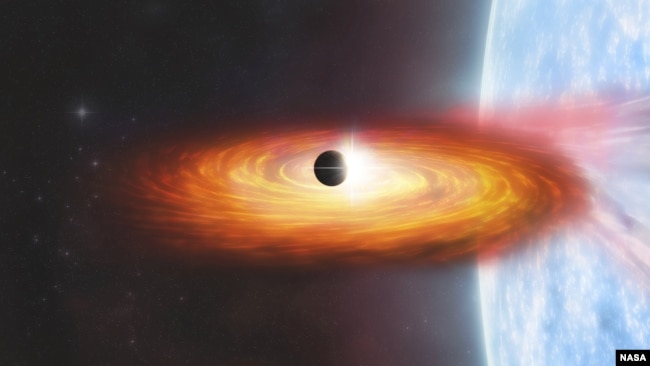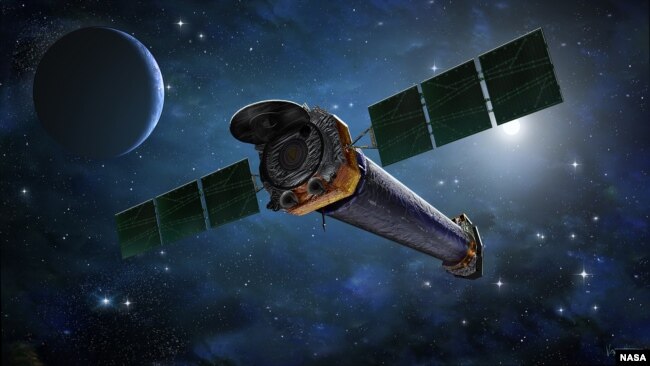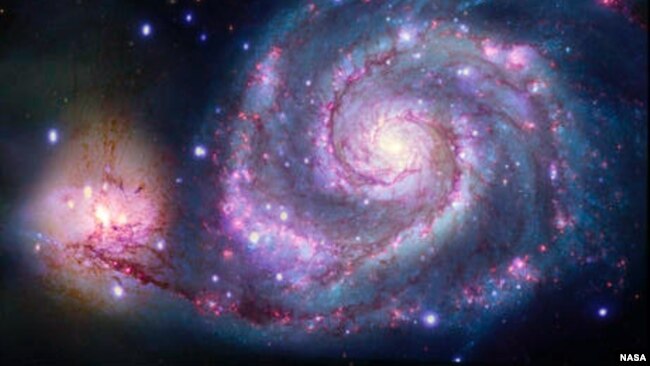果てしない宇宙。
夜、見つめる先には、銀河系外惑星が・・・・・
なんてロマンなんでしょう!! こう言うお話は心の安らぎと心地よい興奮を覚えます。
世間の喧騒を離れ、ひととき宇宙に心を奪われましょう。
さあ、何万光年のかなたに!! ⭐️
NASA、銀河系外の惑星の証拠を初めて公開
NASA Shares First Evidence of Planet Outside Our GalaxyOctober 31, 2021
天文学者たちは、天の川銀河の外側で星の周りを回る惑星の証拠を初めて発見したと発表しました。
この証拠は、アメリカの宇宙機関であるNASAが運営する望遠鏡によって観測されました。これは、チャンドラX線観測所と呼ばれています。NASAによると、この軌道上の観測所は世界で最も強力なX線望遠鏡だといいます。
NASAは最近、この観測所がメシエ51(M51)と呼ばれる銀河の中に新しい惑星を発見したかもしれないと発表しました。この銀河は、“Whirlpool”galaxy”渦巻き銀河”として知られています。この研究は、Nature Astronomy誌に掲載されました。
この可能性のある惑星は、太陽系外惑星と考えられています。太陽系外惑星とは、太陽系外の恒星を周回する惑星のことです。
NASAによると、これまでに4,500個以上の太陽系外惑星が発見され、"確認済み "とされています。他にも数千個の”候補”となる太陽系外惑星が検出されていますが、さらなる調査が必要です。

An artist's rendering of the first planet candidate identified outside of our Milky Way galaxy is pictured next the M51 galaxy. (Credits: X-ray: NASA/CXC/SAO/R. DiStefano, et al.; Optical: NASA/ESA/STScI/Grendler)
天の川銀河の外で発見された最初の惑星候補の想像図は、M51銀河の隣に描かれています。(クレジット X-ray: NASA/CCC/SAO/R. DiStefano, et al.; Optical: NASA/ESA/STScI/Grendler)
しかし、これらはすべて天の川銀河で観測されています。そして、NASAによると、そのほとんどが "地球から約3,000光年以下の距離 "にあるといいます。科学者たちは、M51銀河の太陽系外惑星はもっと遠く、約2,800万光年の距離にあると推定しています。
太陽系外惑星は、望遠鏡で識別するのは難しいのです。軌道上の星の明るい光で隠れてしまうからです。そのためには、星の光量の低下を探す必要があります。これは、惑星が星の前を通過するときに起こる現象です。
過去にNASAの望遠鏡で観測された際には、この方法で星の前を横切る惑星の存在が確認されています。このような、惑星が星の光を部分的に遮る動きを“transits”と呼びます。
今回の発見は、チャンドラX線天文台で検出されたトランジットに基づくものです。しかし、NASAの他の望遠鏡は、観測可能な光の粒を探すのに対し、チャンドラはX線を検出するように設計されています。
チャンドラX線観測所は、”X線星の明るい連星から届くX線の明るさの低下を探した”とNASAは発表しています。これらの連星は、通常、中性子星またはブラックホールが、密接に周回している星からガスを引き込んでいるbright systemsと定義されています。中性子星は、超巨星が自ら崩壊してできた想像を絶する密度の星です。
研究者によると、連星の活動によって、中性子星やブラックホールの近くにある物質が過熱され、X線で光っているのだといいます。しかし、X線が出ている範囲は小さいのです。あまりにも小さいため、その前を通過する惑星がX線のほとんど、あるいはすべてを遮ってしまう可能性があるといいます。

This illustration shows the Chandra X-ray Observatory, which NASA says is the world's most powerful X-ray telescope. It has eight-times greater resolution and is able to detect sources more than 20-times fainter than any previous X-ray telescope.
この図は、NASAが世界最強のX線望遠鏡と称するチャンドラX線観測所。これまでのX線望遠鏡の8倍の解像度を持ち、20倍以上暗い天体を検出することができます。
この方法は、光学望遠鏡に依存する他の光探査システムよりも”はるかに遠くにある太陽系外惑星を検出することができる”とNASAは述べています。
Rosanne Di Stefanoロザンヌ・ディ・ステファノ氏は、マサチューセッツ州ケンブリッジにあるハーバード&スミソニアン天体物理学センターの宇宙物理学者です。この研究チームは、"X線の波長で惑星の候補を探すことで、他の世界を見つけるための全く新しい分野を開拓しようとしている"と声明の中で述べています。
このような方法は、将来、遠くの銀河にある他の新しい惑星を発見するために使われるかもしれない、とディステファノ氏は付け加えています。
研究チームは、今回の観測が実際の "銀河系外惑星 "であることを確認するには、さらに多くのデータが必要であるとしています。問題点としては、この惑星候補の軌道が大きいことが挙げられるといいます。そのため、少なくとも70年間は相手の惑星の前を通過しないと予想され、すぐに確認することはできないといいます。
しかし、この研究の共同執筆者の一人は、チームが発見した結果に非常に自信を持っていると語っています。ニュージャージー州にあるプリンストン大学のJulia Berndtsson氏は、「私たちがエキサイティングで大胆な主張をしていることはわかっているので、他の天文学者が注意深く見てくれることを期待しています」と述べています。また、「私たちは強い主張を持っていると思っていますし、このプロセスこそが科学の仕組みなのです」とも述べています。
NASA Shares First Evidence of Planet Outside Our Galaxy
Astronomers say they have found evidence for the first time of a planet orbiting a star outside our Milky Way galaxy.
The evidence was observed by a telescope operated by the American space agency NASA. It is called the Chandra X-ray Observatory. NASA says the orbiting observatory is the world’s most powerful X-ray telescope.
NASA recently announced that the observatory might have discovered a new planet in the galaxy known as Messier 51 or M51. The galaxy is popularly known as the “Whirlpool” galaxy. The research recently appeared in the publication Nature Astronomy.
The possible planet is considered an exoplanet. These are planets that orbit a star outside of our own solar system.
NASA says that so far, more than 4,500 exoplanets have been discovered and are considered “confirmed.” Thousands of other “candidate” exoplanets have been detected, but require additional study.
But all of these have been observed in the Milky Way galaxy. And NASA says almost all of them are “less than about 3,000 light-years from Earth.” Scientists estimate that an exoplanet in the M51 galaxy would be much farther, about 28 million light-years away.
Exoplanets are hard for telescopes to identify. This is because the bright light of the stars they orbit can hide them. The identification process involves searching for drops in the light levels of stars. Such drops could be caused by a planet passing in front of a star.
This method has been used in past observations by NASA telescopes to confirm the presence of planets crossing in front of stars. These movements -- of planets partly blocking light from stars -- are called “transits.”
NASA’s latest finding is based on a transit detected by the Chandra X-ray Observatory. But unlike other NASA telescopes which search for drops in observable light, Chandra is designed to detect X-rays.
The observatory “searched for drops in the brightness of X-rays received from X-ray bright binaries,” NASA said in a statement. These binaries are defined as bright systems that usually contain a neutron star or black hole pulling in gas from a closely orbiting star. A neutron star is the unimaginably dense result of a supergiant star that has collapsed on itself.
The researchers said the activity of binaries causes the material near the neutron star or black hole to become superheated and glow in X-rays. However, the area producing the X-rays is small. It is so small that a planet passing in front of it could block most or all the X-rays, they added.
This method could permit exoplanets “to be detected at much greater distances” than other light-searching systems that depend on optical telescopes, the NASA statement said.
Rosanne Di Stefano is an astrophysicist at the Center for Astrophysics, Harvard & Smithsonian in Cambridge, Massachusetts. She said in a statement that the research team is seeking “to open up a whole new arena for finding other worlds by searching for planet candidates at X-ray wavelengths.”
Such methods could be used in the future to discover other new planets in distant galaxies, Di Stefano added.
The researchers say more data will be needed to confirm the observation as an actual “extragalactic exoplanet.” They say one problem is that the planet candidate has a large orbit. This means it is not expected to pass in front of its binary partner for at least 70 years, blocking any confirmation attempts anytime soon.
However, one co-writer of the study said the team is very confident with its findings. “We know we are making an exciting and bold claim, so we expect that other astronomers will look at it very carefully,” said Julia Berndtsson of Princeton University in New Jersey. She added: “We think we have a strong argument, and this process is how science works.”
Words in This Story
detect – v. to discover or notice something
glow – v. to produce a soft, warm light
optical –adj. relating to or using light, especially light that can be seen with the human eye
arena – n. a place of scene of activity, debate or conflict
confident – adj. sure about your ability to do things well
bold – adj. not afraid of taking risks
